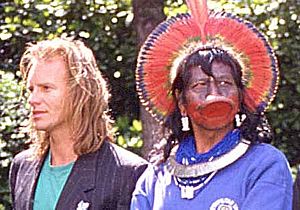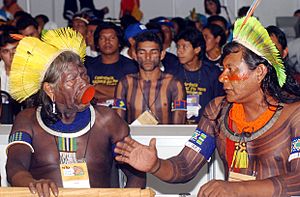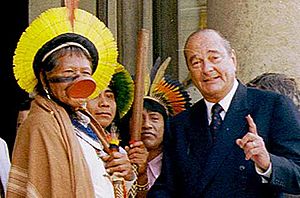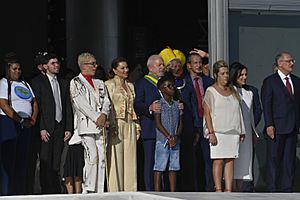Raoni Metuktire facts for kids
Quick facts for kids
Raoni Metuktire
|
|
|---|---|
| Metuktire, Kayapo people leader | |
| Personal details | |
| Born | 1932 (age 92–93) Kapot Indigenous Territory, Mato Grosso, Brazil |
| Known for | Resistance to the Amazon Rainforest industrialization and deforestation |
| Nickname | Raoni |
Raoni Metuktire (born in 1932), also known as Chief Raoni or Ropni, is an Indigenous Brazilian leader. He is also a well-known environmentalist. He is a chief of the Kayapo people. The Kayapo are a Brazilian Indigenous group from the plains of Mato Grosso and Pará in Brazil. Their lands are south of the Amazon River and along the Xingu River and its smaller rivers. Chief Raoni is famous around the world. He is a symbol of the fight to protect the Amazon rainforest and indigenous culture.
Contents
Early Life and Protecting the Amazon
Chief Raoni Metuktire was born in 1932. This was in a village called Krajmopyjakare, deep in the Brazilian Amazon rainforest. His family belonged to the Metuktire group of the Kayapo people. His father was Chief Umoro. The Kayapo tribe often moved from place to place. Because of this, Raoni's childhood involved a lot of travel. He also saw many tribal wars.
When he was 15, in 1947, Raoni chose to wear a special wooden lip plate. His brother Motibau guided him in this tradition. Warriors of his tribe called this plate a botoque.
In 1954, Raoni and his tribe met people from the outside world for the first time. He was 22 years old. A famous Brazilian expert on Indigenous people, Orlando Villas-Bôas, helped Raoni learn some Portuguese language. This helped Raoni prepare for meeting "the others," or "white people," whom the Kayapo called Kuben.
In 1964, Raoni met the former king of Belgium, Leopold III. The king was on a trip to Indigenous lands in Mato Grosso.
A film called Raoni was made in 1978. It was about the Kayapo people and the Amazon. Even back then, cutting down trees (deforestation) was a big worry. The famous actor Marlon Brando appeared in the film. He supported Native American people. He agreed to be in the film for free.
Because of the film and Brazilian news, Raoni became a leader. He spoke out for protecting the Amazon rainforest. The rainforest was in danger from illegal logging, growing too much soya beans, and building hydroelectric dams for electricity.
Working with the World
Raoni became even more famous around the world. This happened because of the musician Sting. Sting met Raoni in the Xingu region in 1987. In 1988, Sting and Raoni held a press conference together. After this, Sting, his wife Trudie Styler, and filmmaker Jean-Pierre Dutilleux started the Rainforest Foundation. Their first goal was to help Raoni protect Kayapo lands from being taken over.
In 1989, Raoni strongly opposed the Belo Monte Dam project. His speeches were shown on TV during a big meeting of chiefs.
From April to June 1989, Raoni visited 17 countries with Sting. This trip was very successful. It helped people all over the world learn about deforestation. Twelve rainforest foundations were created. They raised money to create a huge national park in the Rio Xingu River area. This park would be in the Brazilian states of Para and Mato Grosso. Raoni's dream was to connect several Indigenous territories. If joined, these lands would cover about 180,000 square kilometers. This is almost one-third the size of France.
In 1993, the money raised worldwide helped Raoni's dream come true. The Xingu Indigenous lands were joined together. This created one of the world's most important rainforest reserves.
A Global Voice for the Amazon
Former French president Jacques Chirac called Raoni a living symbol. He said Raoni represented the fight to protect the environment. Since 1989, Chief Raoni has traveled to many places. He visited the Innu people in Quebec, Canada, in 2001. He also went to Japan in 2007. His messages were especially well received in European countries like France. He visited France in 2000, 2001, and 2003.
The Indigenous peoples of the Xingu region lived apart from the rest of the world until the 1900s. They worked hard to pass down their traditions by telling stories for many generations. Raoni found ways to connect these cultures with the world. He did this while keeping his people's dignity. Even though he meets important people in many countries, he lives in a simple hut. He does not own much. Any gifts he receives are always shared with others.
When he appears in public, he almost always wears a wreath of yellow feathers. He also wears Kayapo earrings and necklaces. He is easy to recognize because of his lip plate. This plate stretches his lower lip. Younger generations have not continued this tradition. Raoni is one of the last men to wear a lower lip plate.
In September 2011, the mayor of Paris, Bertrand Delanoë, made Chief Raoni an honorary citizen of Paris. He also received a medal from the French National Assembly. In 2019, a group of environmentalists and experts suggested him for the 2020 Nobel Peace Prize. This was for his lifelong work protecting the forest.
In a September 2021 interview, Raoni said he wanted to keep fighting. Even at his age, he said: "All those people, with the help of the current government, have already planned to deforest it all. I will not let them do it. (...) So, I will continue the fight and we must work with our friends to set up a new campaign."
Fighting the Belo Monte Dam
In 2010, Raoni went on a trip to Europe. He visited France, Belgium, Switzerland, Monaco, and Luxembourg. During this trip, he spoke out strongly against the Belo Monte Dam project. This dam would put Indigenous lands along the Xingú river in Brazil at risk. He said he was determined to protect the Amazon rainforest from this big problem. He even said, "I asked my warriors to be ready for the war. I told the tribes of the High Xingú the same. We will not be pushed around."
During his trip, he promoted his book, Raoni, mémoires d'un chef indien. He was welcomed by former French president Jacques Chirac. He also supported Fondation Chirac. This group works to protect Indigenous cultures and the rainforest's plants and animals.
He was also welcomed by Albert II, Prince of Monaco. Prince Albert is known for supporting nature protection. However, the former French president Nicolas Sarkozy did not meet Raoni during this trip.
On June 1, 2011, the Brazilian Institute of Environment and Renewable Natural Resources (IBAMA) approved the dam. This was the last step before construction could begin. News and social media shared this information with a picture of Raoni crying. Many people thought his tears were because of the dam's approval. But Chief Raoni said on his official website that this was not true. He said, "I didn't cry because of the authorization of the construction of the Belo Monte dam and the beginning of the construction (…). President Dilma will cry but I will not." He explained that it is a Kayapo custom to cry when greeting an old friend or family member they haven't seen in a long time. This was happening when the photo was taken.
In September 2011, Chief Raoni went to the United Nations Human Right Council in Geneva. He also took part in the Rio+20 conference in June 2012. Raoni did not give up. He received support from famous people like James Cameron, Sigourney Weaver, and Arnold Schwarzenegger. He also started an international petition in 7 languages against the Belo Monte dam project on his official website.
However, the President of Brazil, Dilma Rousseff, did not listen to Chief Raoni's pleas. The dam was built. The building of the dam was later linked to a large corruption problem in President Rousseff's government. Chief Raoni became the biggest symbol of opposition to the Belo Monte dam.
Presidential Inauguration in 2023
On January 1, 2023, Raoni took part in the ceremony for Luiz Inácio Lula da Silva becoming president of Brazil. He walked up the ramp to the presidential palace with Lula and seven other people. These people represented different groups in society. Raoni helped give the presidential sash to the new Chief of State. The previous president, Jair Bolsonaro, had left Brazil two days before the ceremony.
Awards and Recognition
Chief Raoni has received several important awards for his work:
| Award or decoration | Country | Date | |
|---|---|---|---|
| Commander of the Order of Cultural Merit | 23 October 2007 | ||
| Grand Cross of the Order of Rio Branco | 21 November 2023 | ||
| Chevalier of the Legion of Honour | 26 March 2024 | ||
See also
 In Spanish: Raoni Metuktire para niños
In Spanish: Raoni Metuktire para niños
- Raoni (also known as Raoni: The Fight for the Amazon) is a 1978 Belgian documentary film. It was directed by Jean-Pierre Dutilleux and Luiz Carlos Saldanha. The film shows the challenges faced by Indigenous tribes in north central Brazil. It was nominated for an Academy Award for Best Documentary Feature.






